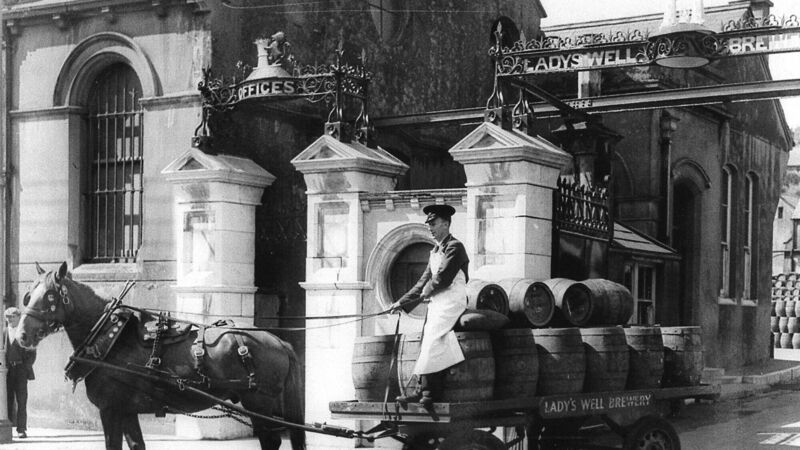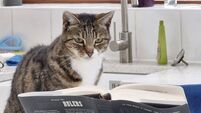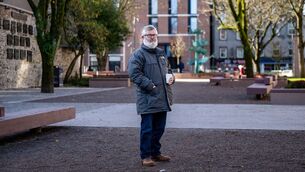Michael Moynihan: We need an app to create a fragrant trip through Cork’s streets

A horse and cart crossing Patrick's Bridge to deliver barrels of Murphy's stout to a pub in Cork city in the early part of the last century
A few months ago I wrote here about a smell in Cork so pervasive it seemed to pursue me everywhere, curling its way in under doors, gathering in an unseen cloud to besiege me at bus stops and shop entrances.
It was the smell of weed, and when I raised a light objection to its ubiquity in the city the online reaction was ... suffice to say it rather undercut the idea that smoking the substance has a relaxing effect on its users.
I raise the matter here again because an old acquaintance reminded me over the weekend of a smell in the city that now seems to be gone, but which was pretty pervasive in its time, albeit within a more localised zone than the greater Cork area submerged under the weed-cloud.
When we were in primary school our route to the classroom was rarely the straightest point between home and the front door of the Mon, and we often wandered up from the bus stop on the Watercourse Road. However, when we stepped off the bus — the old number 12, only taken on rainy mornings — we were often stopped in our tracks by the smell from Murphy’s Brewery, its towering smokestack then still frowning down on all in Blackpool.
That powerful, evocative odour no longer seems to figure in the atmosphere, though; when I roll through the area at random times I rarely get that hoppy whiff which, if truth were told, sometimes was so strong we felt like getting back on the old number 12, with the windows shut tight for some protection.
Perhaps the environment contributed to the effect at that time. The towering smokestack and dark, looming buildings on either side of the street gave the impression of trapping the smell — not the impression given by the airier streetscape which exists there now.
Strong smells can be more than a warmly remembered memory, though.
Anyone with a half-decent memory may remember in 2014 there was a terrible stink in the city for quite some time — the hashtag du jour was #corkpong — which had us all baffled (and our noses crinkled). In time, it emerged that the Port of Cork had been dredging the river, activity which is always likely to disturb layers of mud and silt and release various smells.
That experience brought me back in turn to a terrible day or two back in the eighties, when a lorry leaked much of its load of chemicals on Dublin Hill and throughout Blackpool en route to a perfume factory; the resulting smell meant a fair chunk of the city reeked like a steroidal ladies’ bathroom in a disco from the seventh level of hell.
Until it rained, and then the slithery mess just stank like a load of rotting chemicals destined for a perfume factory, something from a far lower circle of hell.
City odours and urban design
On a serious note, the smells of the city can help to improve the urban experience. I see that data scientists at the University of Cambridge came up with a project to show how tracking city odours can help with better urban design.
They started in a pretty analogue way, taking local volunteers in cities on a series of “smell-walks”, to identify particular urban smells. From this exercise, they drew up an urban smell dictionary with entries ranging from “exhaust”, “manure”, “trash”, “putrid”, and “vomit” on one hand to “lavender”, “fruity”, “barbecue”, and “baked” on the other.
Then they got digital, taking two cities, London and Barcelona, and searching for their designated smell words in geotagged posts on social media platforms (their research ran through 17m Flickr images, 436,000 Instagram posts, and 1.7 m tweets).
They then created maps with emissions smells in red and ‘nature’ smells in green. Unsurprisingly they found most of the red along the cities’ thoroughfares and main roads, and the green in parks, forests, and so on.
This might provoke a ‘so what?’ response from the cynical reader, but the scientists point out that urban planners could then see which areas of a city smell the worst and consider solutions — air-flow manipulation, green spaces, and pedestrian-friendly streets which might improve those areas’ smell.
Or an app could be created using the information to track the best-smelling path to a walker’s destination.
Or city officials could use such social media data to monitor how their residents are being affected by smells — and by the pollution that creates that smell.
An app that would create a fragrant trip through Cork would be a fine development. There are plenty of premises generating sweet smells which could be used as way stations on one’s journey — the sheer number of barbershops and hairdressing emporia, for instance, would make it relatively easy to get from the Harbour Commissioners building to the gates of UCC by inhaling Brylcreem and L’Oreal Just For Men.
Likewise, the coffee shops on Leeside — whose number is only rivalled by the barbershops — could be the markers of a trip around the city fuelled by the aromas of 3FE and (your columnist’s favourite) Coffee Republic.
Take that idea further — are there enough bakeries in Cork to sustain our sweet-smelling app? Enough florists?4
Ghost smells
This is an important point when it comes to the odour of the city; our default is the bad smell. The stink from the river, or the slaughterhouse, or the brewery, is what we tend to focus on when there are so many better alternatives. That vaguely metallic petrichor after rain on the quays along the Lee. The cooling mustiness coming from the dark of St Augustine’s on a hot summer’s day. Not to mention the ghost smells — the buttery whiff near Shandon left behind by the tons of the stuff that went through the Butter Exchange, or the heavy, cloaking reek left by a million cows which were loaded at Penrose Quay over the years.
The reference to livestock is not an accident, by the way. In recent years we’ve grown accustomed to looking back one hundred years to commemorate the various anniversaries of the birth of the state, but if we went back even further we’d encounter a far more pungent city.
By the late 19th century Cork’s buses, carts, drays, and cabs were drawn by horses, which in turn generated cohorts of workers — blacksmiths to shoe them, jarveys to drive them, and grooms to care for them. There was no shortage of work for those in the equine sector — in 1837, for instance, there were 300 jingles (a particular form of Cork horse-drawn cab, as you’ll know from your Joyce) plying their trade between Cork and Passage alone.
There was no shortage of something else as well. On average a horse will produce between 15 and 35 pounds of manure per day, as well as a couple of pints of urine. The issue was so pressing that it was debated at the world’s first international urban planning conference in New York in 1898.
Be thankful we don’t have to hold our noses as soon as we hit town. Or watch out for the large piles.
CONNECT WITH US TODAY
Be the first to know the latest news and updates











